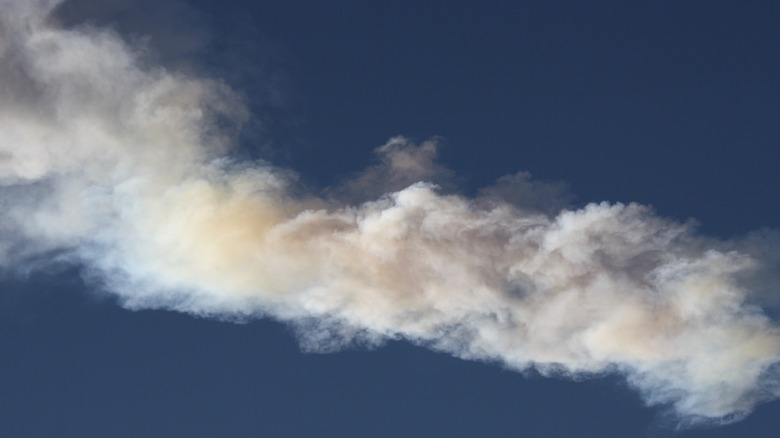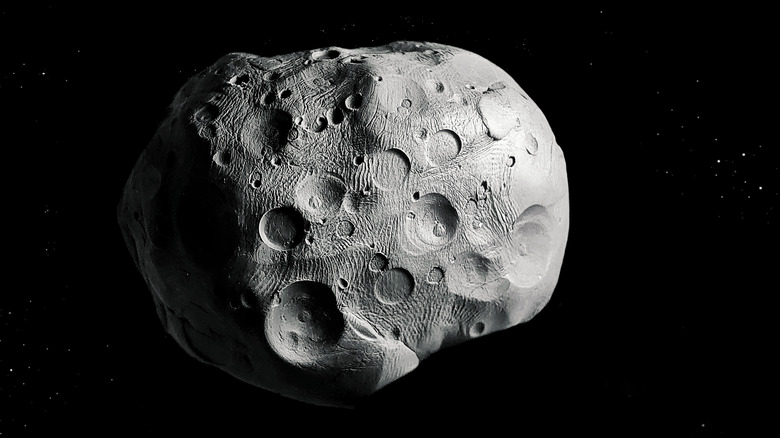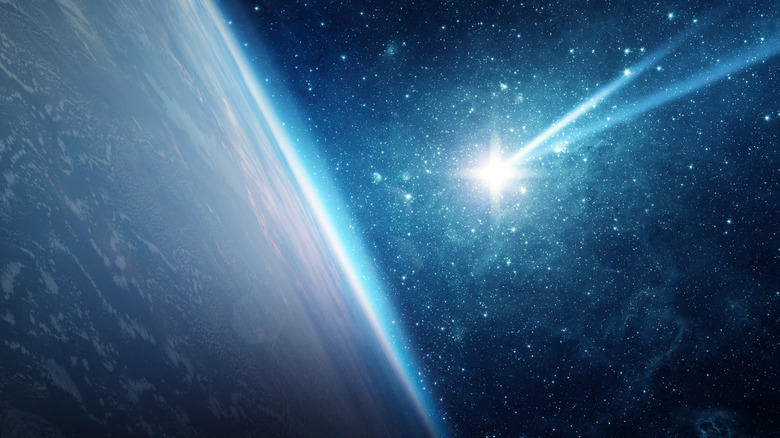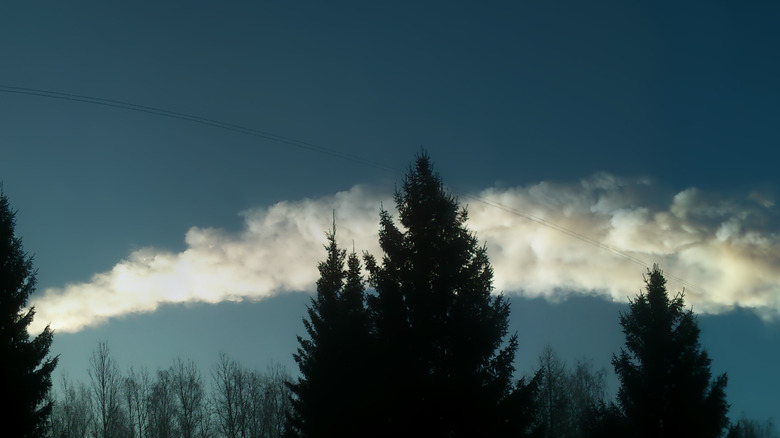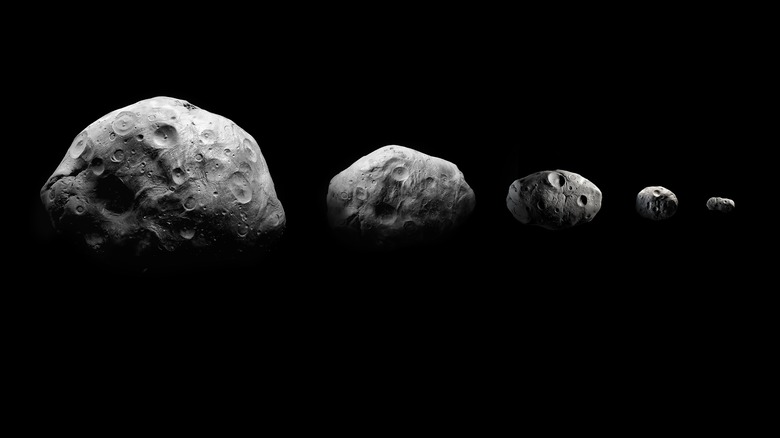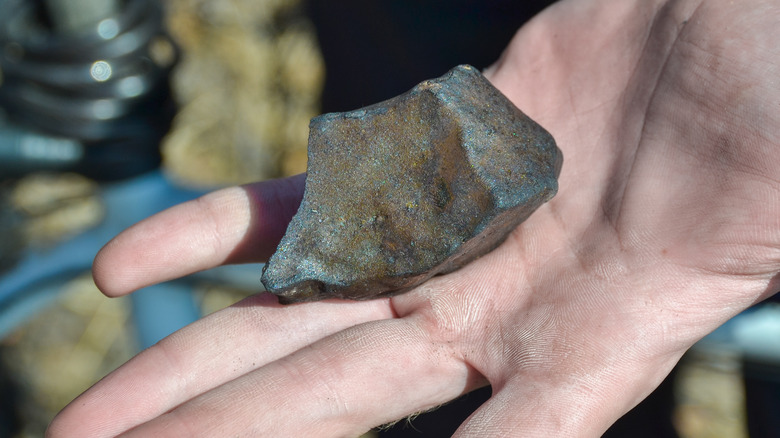What Was The Russian Meteor And Where Did It Come From?
On the morning of February 15, 2013, a small asteroid exploded over Russia in a blast that had approximately 500 kilotons of energy, which is around 33 times the energy of the Hiroshima atomic bomb (per CNN). It was so powerful that it lit up the sky. One witness, 23-year-old Denis Kuznetsov, told CNN at the time that it was like "ten suns." "This is no exaggeration," he added.
The explosion took place about 20 miles above the city of Chelyabinsk, but it actually blew out windows and flattened buildings in six different cities, according to EarthSky. Around 1,500 people were injured enough to seek out medical attention, mostly because of broken glass. While most of the injuries were minor, one woman had to be flown to Moscow when the shockwave injured her spine. Local officials estimated that the asteroid caused $33 million in damages. Luckily, no deaths were reported (via The Guardian).
What's in a name?
The Russian meteor is referred to as both an asteroid and a meteor. According to NASA, an asteroid is a rock smaller than a planet that orbits the sun. Most of the asteroids in our solar system orbit in an area called the asteroid belt between Mars and Jupiter, but some asteroids have an orbit that brings them closer to Earth. A meteor, on the other hand, is what happens when a chunk of an asteroid or comet enters the Earth's atmosphere and vaporizes, turning into a streak of light (they are what we see as shooting stars). A meteoroid is the name for the chunk of asteroid that causes a meteor, and a meteorite is the name for any piece of the meteoroid that survives the trip to Earth's surface.
Of course, the Russian meteor was much brighter than your average shooting star. As EarthSky explained, the asteroid exploded when it hit Earth's atmosphere, and the blast was the most powerful caused by an asteroid since another incident over Russia in 1908. This explosion, which occurred over Tunguska in a remote part of Siberia, killed reindeer and flattened about 80 million trees over an area of 820 square miles, CNN reported. "We would expect an event of this magnitude to occur once every 100 years on average," Paul Chodas of NASA's Near-Earth Object Program Office at the Jet Propulsion Laboratory in California told CNN.
Small dangers
The asteroid was a reminder that "space is out to kill you," as WIRED put it. It was relatively small for an asteroid, approximately the size of a six-story building, and weighed around 11,000 tons (via Space.com). It is very hard for scientists to track asteroids of that size before they reach the atmosphere, as NASA's and the European Space Agency's asteroid tracking programs tend to focus on larger rocks so that they can predict potential impacts years or decades ahead of time. This is effective for the larger asteroids it targets but not for smaller ones. And once a smaller asteroid enters the atmosphere, a missile defense system would not be very effective against it. A lucky shot would merely shatter it into smaller pieces rather than alter its course, and actually making the shot would be extremely difficult (the Russian meteor was traveling at around 32,000 miles per hour).
After the event, NASA formed a Planetary Defense Coordination Office. The purpose of this office was to look at data from the Near-Earth Object observations program, identify and monitor potentially dangerous objects, provide information about them, and organize any necessary response. However, this program tracks asteroids that are 98 to 164 feet or larger, and the Russian meteor was about 55 feet.
Origin story
In the days immediately following the incident, astronomers were able to trace where the asteroid had come from. "Using evidence gathered by one camera at the Revolution Square in the city of Chelyabinsk and other videos recorded by witnesses in the close city of Korkino, we calculate the trajectory of the body in the atmosphere and use it to reconstruct the orbit in space of the meteoroid previous to the violent encounter with our planet," study authors Jorge Zuluaga and Ignacio Ferrin wrote on the Arxiv website. The team — from the University of Antioquia in Medellín, Colombia — also considered the meteor's impact site in Lake Chebarkul, BBC News reported.
Based on this data, the pair used trigonometry to calculate the asteroid's height, speed, and position as it fell. They then used six properties of its path to reconstruct its orbit and put their results into U.S. Naval Observatory astronomy software. The result? The Russian meteor came from the Apollo asteroids. University of Kent scientist Dr. Stephen Lowry, who was not part of the study, agreed with its results. "It certainly looks like it was a member of the Apollo class of asteroids," he told BBC News.
The Apollo asteroids
The Apollo asteroids are a well-known asteroid family that crosses Earth's orbit, according to BBC News. They are one of four groups of near-Earth asteroids (NEA), which are defined by their perihelion distance (the point in an orbit closest to the sun), aphelion distance (the point in an orbit farthest from the sun), and semi-major axes (the distance between an orbit's center and farthest point), according to NASA. The Apollo asteroids are all Earth-crossing NEAs with a semi-major axis larger than Earth's. They are named after the asteroid 1862 Apollo.
The Apollo asteroids are believed to have originated in the asteroid belt before Jupiter's gravity knocked them into their current orbits, according to Cosmos — The SAO Encyclopedia of Astronomy. For asteroids, they have short lifespans of around 10 million years because they tend to collide with inner planets, as Chelyabinsk can attest. Therefore, their numbers are constantly being replaced. Currently, scientists are aware of more than 1,600 of them.
Leftovers
Scientists were able to learn even more about the origins of the Russian meteor by finding the fragments it left behind on Earth. Immediately after the explosion, local residents found meteorites in snowbanks, according to EarthSky. Some of the fragments were collected by teams of volunteers on skis, Popular Science reported. These fragments allowed scientists to determine that the asteroid was a chondrite, the most common type of asteroid near Earth. They said it spent around 4.5 billion years in space before its crash.
On the day of the explosion, a 20-foot hole was also discovered in the frozen surface of Lake Chebarkul, according to EarthSky. Scientists explored the site further in June of that year and discovered a large meteorite buried in the lake sediments. In October, they pulled a 1,442-pound fragment of the rock to the surface. It remains the largest chunk of the Russian meteor ever recovered.
